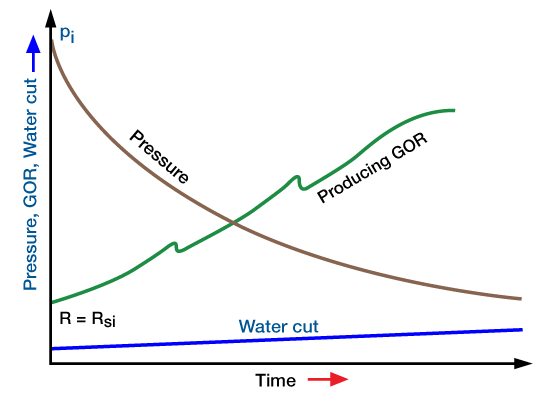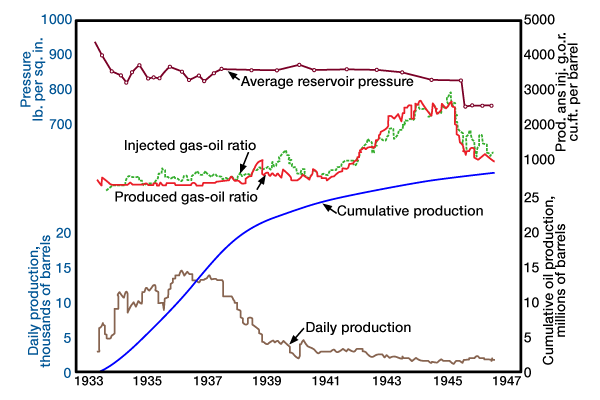Gas Cap Drive
Production Mechanism
The same theoretical methods for computing recovery from solution gas drive reservoirs may be applied to gas cap drive reservoirs. The assumptions are (1) that no gravity segregation of the gas liberated from the oil occurs, and (2) that the gas cap gas diffuses through the oil to supply additional expansion energy, while the location of the gas-oil contact remains at its original position.
In reality, the gas-oil contact moves downward, although en gineers attempt to maintain the gas cap movement at a uniform level for optimum recovery. If the gas cap shows definite expansion as indicated by a high level of reservoir pressure, and the producing wells remain at low gas-oil ratio, gravity is maintaining a uniform movement of the gas cap. The low produced gas-oil ratio continues until the gas cap reaches the wells, at which point a sizeable increase in the produced gas-oil ratio occurs. Recovery in such cases is greatly dependent on the completion intervals and well locations.
Typical Producing Performance
Pressure, GOR, Water Production Profiles
Muskat (1949) published a theoretical study of the effect of gas cap size on reservoir pressure and recovery. His results show that the presence of an active gas cap causes additional recovery over that obtained from solution gas drive, and causes higher pressure throughout the reservoir life. The produced gas-oil ratio is lower in the early production life and much higher in the late production life (Figure 1). Fluctuations in the GOR will result from successive high GOR production rates from wells higher on the structure.

The presence of a gas cap has no significant effect on water production, and it is assumed that no aquifer exists. Water production due to connate water saturation, if it occurs, will be insignificant, or will be similar in nature to that for a solution gas drive reservoir.
Selective GOR Control
As we stated earlier, if the gas cap expands uniformly because of gravity segregation, the gas-oil ratio will increase dramatically when the gas cap reaches the perforated intervals in a producing well. It is advisable in this case to close or recomplete the wells at a lower interval. Continued production without recompletion will not result in any appreciable additional oil from the wells, but will result in considerable loss of gas that should be kept in the reservoir to maintain the pressure. In some reservoirs, the gas may cusp into a producing well through a permeable zone. This also results in less recovery. Selective recompletion, or the shutting in of wells, should be considered to prevent unnecessary depletion of the reservoir energy.
Recovery Factor
Gas cap gas drive generally results in a higher recovery when compared to solution gas drive. As a rule of thumb, the additional recovery can range from as low as 1% to as high as 10%. Recovery is affected by the size of the gas cap, and the degree of the heterogeneity of the reservoir. The larger the gas cap, and the less the degree of heterogeneity, the higher the additional recovery. Furthermore, the location of the wells can appreciably affect recovery. For gas cap drive reservoirs, the wells should be ideally located down dip. If the gas cap advances uniformly, and gravity segregation maintains the uniform advance, overall recovery can be very high and may be over 50%. This value for recovery is normally associated with gravity drainage.
A Case History of a Gas Cap Drive Reservoir
In this case history, based on Muskat (1949) and Craft and Hawkins (1959), we see a good example of a gas cap expansion associated with a substantial gravity drainage, as shown by the performance of the Parinas Sandstone reservoir of the Mile Six Pool in Peru. The formation has an average angle of dip of 17°30’ and an average cross-sectional area of 1,237,000 sq ft (114917 ![]() ). The oil had a specific gravity of 0.78, a viscosity of 1.32 cp, an average specific permeability of 0.3 darcy, and an initial solution gas of 400
). The oil had a specific gravity of 0.78, a viscosity of 1.32 cp, an average specific permeability of 0.3 darcy, and an initial solution gas of 400 ![]() (71.2
(71.2 ![]() ) at 850 psia (5.86 MPa) original reservoir pressure. Gas of the original overlain gas cap had a viscosity of 0.0134 cp.
) at 850 psia (5.86 MPa) original reservoir pressure. Gas of the original overlain gas cap had a viscosity of 0.0134 cp.
This field had been subjected to a complete pressure-maintenance operation throughout its history (since 1933) by returning produced gas to the gas cap. Thus, the reservoir pressure had been maintained within 200 psi (1.38 MPa) of its original value (850 psi) (5.86 MPa). The gas-oil contact moved over a vertical distance of more than 400 ft (131 m) as the result of gas cap expansion during the first five years of oil production. This expansion undoubtedly had been facilitated by the effective gas injection and the pressure maintenance opera tion that had been initiated at the beginning. The limited rise in gas-oil ratio shown during the producing life indicates that in the downstructure oil saturation had been maintained at a high level as a result of oil gravity drainage. The reser voir pressure remained almost constant up to 1946. This indi cates that the injected gas had remained in the gas cap and was not being dissolved in the oil zone to supplement the solution gas drive mechanism. A combination of a high structural relief, good formation permeability, and low viscosity of oil had formed a most favorable condition for the development of a significant gravity drainage in this field. With gas injection, at an average rate, exceeding the gas withdrawals, the pressure was kept almost constant. The GOR increased very little, caus ing a continuous expansion of the gas cap and a lowering of the gas-oil contact. As a result of these favorable conditions, in conjunction with good oilfield practice, oil recovery reached above 85% of the initial oil in place. Figure 2 shows the performance characteristics of this oil field.

 Petro Shine The Place for Oil and Gas Professionals.
Petro Shine The Place for Oil and Gas Professionals.



